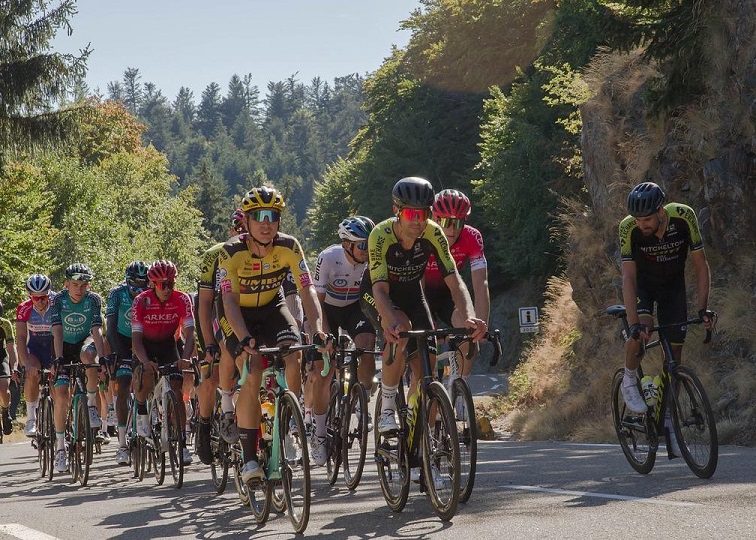The Tour de France’s 109th edition covers a total distance of 3328 kilometres (2068 miles), making it the second-longest of the three Grand Tours in 2022, after the Giro d’Italia (3410.3 kilometres) (La Vuelta a Espana is the shortest at 3280.5km).
The Tour de France is the most important cycling event of the year. It consists of 21 phases and two days of relaxation, for a total of 23 days. This year, because the Grand Départ occurs in Denmark, a ‘transfer day’ has been added to bring the entire race time to 24 days. To make up for it, the race starts a day early on Friday, July 1st.
This year’s Tour de France is shorter than previous year’s edition, which covered 3414 kilometres, and is the race’s fourth shortest in modern history. The first three editions of the race covered less than 3000 kilometres but were divided into only six difficult stages. Following that, the Tour de France became significantly longer, with distances topping 5000 kilometres in the 1920s and consistently exceeding 4000 kilometres until the 1980s, when distances began to be reduced.
Now, over the course of three weeks, the race has reached a happy medium, incorporating a variety of distances that make for exciting and unpredictable racing while remaining within the capabilities of the modern peloton.

2022 Tour de France: How Time Has Evolved The Tour
Table of Contents
Below is the compiled key information needed to understand the 2022 Tour de France:
- Tour de France Race distance and challenges insights
- Tour de France Average Speed
- Tour de France: Distances from last 10 Editions
- Average Speed in the Tour de France in Last 10 years
Tour de France Race distance and challenges insights
Distance isn’t the only consideration. Riders confront a variety of challenges during the course of a Grand Tour’s 23 days.
The event kicks off this year with a 13-kilometer time trial in Copenhagen, Denmark’s capital.
There will be a total of 53 kilometers contested against the clock in 2022, thanks to a longer time trial on Stage 20.
Time trial specialists will compete for the yellow jersey on Stage 1, with sprinters competing on the final two stages in Denmark.
The race will cover a total distance of 394 kilometers in Denmark, with stages 9 and 10 taking place in Switzerland, making the 2022 course a total of four countries visited.
Race will then heads to France for the final stages, with riders facing the cobblestones of Northern France and Belgium for the first time in four years on Stage 5 – 19.4 kilometers of pave divided into 11 sectors varying in length from 1.3 to 2.8 kilometers.
The race’s longest stage, Stage 6, runs through the Ardennes from Binche to Longwy over 220 kilometers, making it one of just two stages with a distance of 200 kilometers or more.
As the riders face the tremendous hills of the Alps and Pyrenees later in the race, elevation meters will be foremost in their minds.
The race will climb a total of 48,530 meters, with Stage 11 gaining the greatest height. The riders will reach a maximum altitude of 2642 meters atop the Col du Galibier, which they will climb twice, once on Stage 11 and again on Stage 12.
Tour de France Average Speed
While the distances have decreased over time, the average speed of the participants has risen substantially.
Professional cyclists have been able to go faster than ever before thanks to a slew of advances in equipment and clothes, as well as a slew of scientific advancements in training and nutrition.
Although Maurice Garin, the winner of the inaugural Tour de France, averaged 25.7 kilometers per hour, this was not the slowest Tour de France ever.
The winner of the 1919 event, the first after the First World War, averaged only 24 kilometers per hour.
Winning riders in the modern era often average around 40 kilometers per hour. Tadej Pogaar averaged 41.2kpm on his road to victory in 2021, making him the second quickest winner in history. Although this statistic is legally meaningless because the UCI declared the races during the Armstrong era to be without victors, the fastest was in 2005.
The modest differences in speed in recent years could be due to the kind of route rather than the ability of the winning rider. The course, for example, had four summit finishes in 2020 and three in 2021. With five scheduled for 2022, we may anticipate a little slower average speed for whoever emerges victorious.
Tour de France: Distances from last 10 Editions
- Tour de France 2022: 3,328 kilometers / 2,068 miles
- Tour de France 2021: 3,414 kilometers / 2,122 miles
- Tour de France 2020: 3,484 kilometers / 2,165 miles
- Tour de France 2019: 3,366 kilometers / 2,091 miles
- Tour de France 2018: 3,351 kilometers / 2,082 miles
- Tour de France 2017: 3,540 kilometers / 2,200 miles
- Tour de France 2016: 3,529 kilometers / 2,193 miles
- Tour de France 2015: 3,360 kilometers / 2,088 miles
- Tour de France 2014: 3,661 kilometers / 2,275 miles
- Tour de France 2013: 3,404 kilometers / 2,115 miles

Average Speed in the Tour de France in Last 10 years
- Tour de France 2021: Tadej Pogačar –2 kph
- Tour de France 2020: Tadej Pogacar – 39.9 kph
- Tour de France 2019: Egan Bernal – 40.6 kph
- Tour de France 2018: Geraint Thomas – 40.2 kph
- Tour de France 2017: Chris Froome – 41 kph
- Tour de France 2016: Chris Froome – 39.6 kph
- Tour de France 2015: Chris Froome – 39.6 kph
- Tour de France 2014: Vincenzo Nibali – 40.6 kph
- Tour de France 2013: Chris Froome – 40.5 kph
- Tour de France 2012: Bradley Wiggins – 39.8 kph
Contact Us
If you have any suggestions or advise, please feel free to reach us via our Contact Us here.
DIY Research
If you are a research nerd then we highly recommend that treat Google as your best friend.
